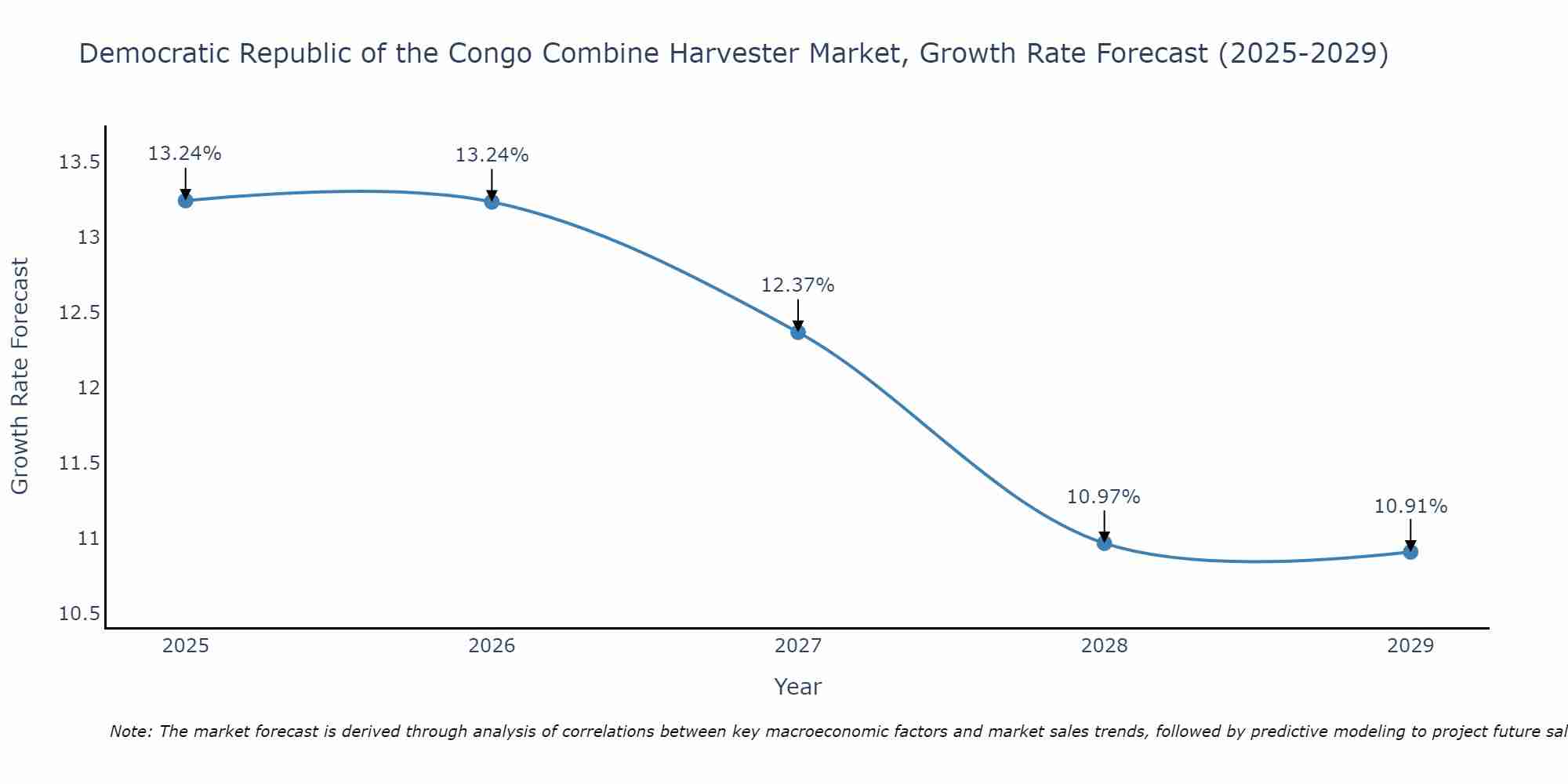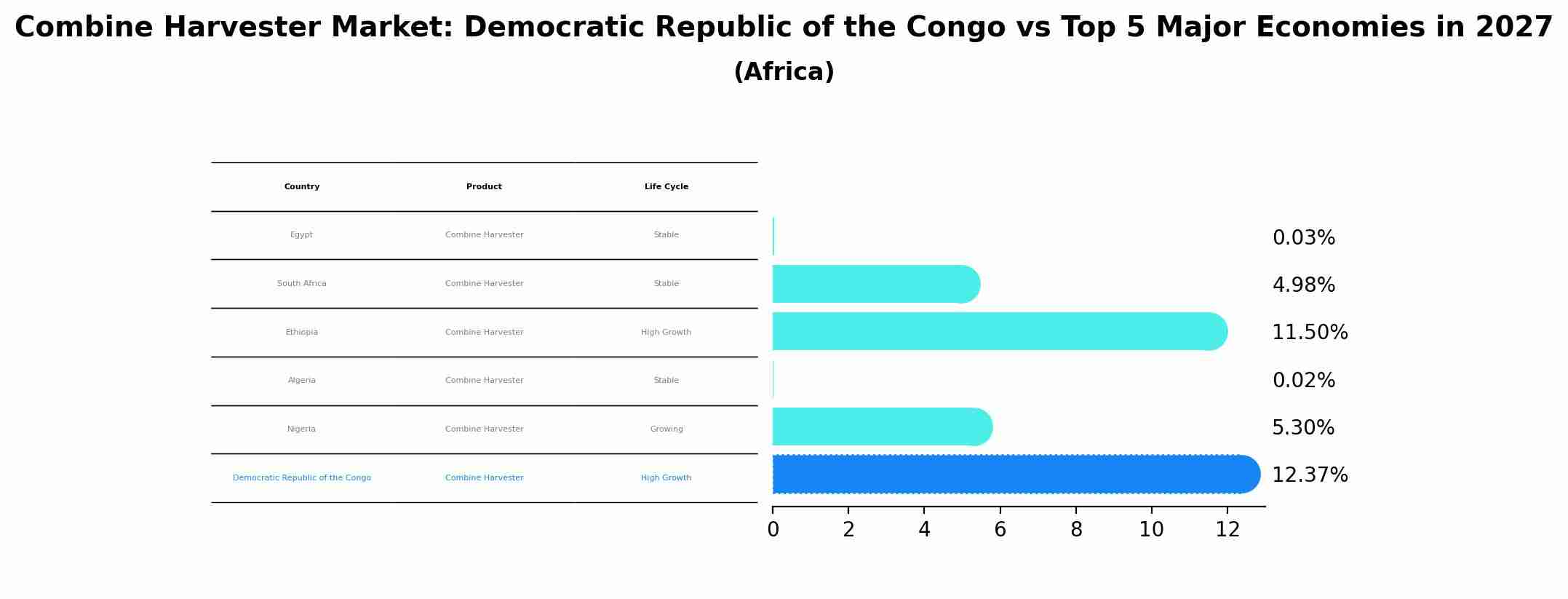Congo Combine Harvester Market (2025-2031) | Share, Analysis, Trends, Size, Segmentation, Companies, Revenue, Value, Growth, Forecast, Outlook & Industry
| Product Code: ETC5398223 | Publication Date: Nov 2023 | Updated Date: Oct 2025 | Product Type: Market Research Report | |
| Publisher: 6Wresearch | Author: Bhawna Singh | No. of Pages: 60 | No. of Figures: 30 | No. of Tables: 5 |
Democratic Republic of the Congo Combine Harvester Market Size Growth Rate
The Democratic Republic of the Congo Combine Harvester Market could see a tapering of growth rates over 2025 to 2029. Starting high at 13.24% in 2025, the market steadily declines to 10.91% by 2029.

Combine Harvester Market: Democratic Republic of the Congo vs Top 5 Major Economies in 2027 (Africa)
The Combine Harvester market in Democratic Republic of the Congo is projected to grow at a high growth rate of 12.37% by 2027, within the Africa region led by Egypt, along with other countries like South Africa, Ethiopia, Algeria and Nigeria, collectively shaping a dynamic and evolving market environment driven by innovation and increasing adoption of emerging technologies.

Congo Combine Harvester Market Overview
The Congo Combine Harvester Market is experiencing growth due to increasing agricultural mechanization and the need to boost productivity. The market is driven by the rising demand for efficient and time-saving harvesting solutions in the countrys agricultural sector. However, the market faces challenges such as high initial investment costs, limited access to financing, and inadequate maintenance infrastructure. Additionally, small-scale farmers may find it difficult to adopt such machinery due to cost and scale constraints.
Drivers of the market
The Congo combine harvester market is primarily driven by the growing mechanization of agriculture to improve productivity and efficiency. Rising labor costs and the need to meet food demand from a growing population are pushing farmers towards adopting modern agricultural machinery, including combine harvesters.
Challenges of the market
The Congo Combine Harvester Market is hampered by a lack of access to modern agricultural equipment, with most farmers relying on outdated or manual methods of harvesting. The high cost of combine harvesters is another significant barrier to market growth, particularly for small-scale farmers who dominate the agricultural sector. Inadequate financial services and limited access to credit further restrict farmers` ability to invest in such equipment. Additionally, poor infrastructure and distribution networks affect the availability of spare parts and after-sales services, further hindering the market.
Government Policy of the market
In the Congo Combine Harvester Market, government policies are aimed at boosting agricultural productivity and ensuring food security. The government provides subsidies and financial assistance to farmers for purchasing combine harvesters, making these machines more accessible to small and medium-sized farms. There are also policies promoting the mechanization of agriculture, which include training programs for farmers on the use of combine harvesters and other modern farming equipment. Import duties on agricultural machinery have been reduced to make these products more affordable and encourage adoption.
Key Highlights of the Report:
- Congo Combine Harvester Market Outlook
- Market Size of Congo Combine Harvester Market, 2024
- Forecast of Congo Combine Harvester Market, 2031
- Historical Data and Forecast of Congo Combine Harvester Revenues & Volume for the Period 2021-2031
- Congo Combine Harvester Market Trend Evolution
- Congo Combine Harvester Market Drivers and Challenges
- Congo Combine Harvester Price Trends
- Congo Combine Harvester Porter`s Five Forces
- Congo Combine Harvester Industry Life Cycle
- Historical Data and Forecast of Congo Combine Harvester Market Revenues & Volume By Cutting Width for the Period 2021-2031
- Historical Data and Forecast of Congo Combine Harvester Market Revenues & Volume By Small Size Combine Harvester for the Period 2021-2031
- Historical Data and Forecast of Congo Combine Harvester Market Revenues & Volume By Large Size Combine Harvester for the Period 2021-2031
- Historical Data and Forecast of Congo Combine Harvester Market Revenues & Volume By Type for the Period 2021-2031
- Historical Data and Forecast of Congo Combine Harvester Market Revenues & Volume By Wheel Type Combine Harvester for the Period 2021-2031
- Historical Data and Forecast of Congo Combine Harvester Market Revenues & Volume By Crawler Type Combine Harvester for the Period 2021-2031
- Historical Data and Forecast of Congo Combine Harvester Market Revenues & Volume By Power Source for the Period 2021-2031
- Historical Data and Forecast of Congo Combine Harvester Market Revenues & Volume By Tractor Pulled/PTO Powered Combine Harvester for the Period 2021-2031
- Historical Data and Forecast of Congo Combine Harvester Market Revenues & Volume By Self-Propelled Combine Harvester for the Period 2021-2031
- Congo Combine Harvester Import Export Trade Statistics
- Market Opportunity Assessment By Cutting Width
- Market Opportunity Assessment By Type
- Market Opportunity Assessment By Power Source
- Congo Combine Harvester Top Companies Market Share
- Congo Combine Harvester Competitive Benchmarking By Technical and Operational Parameters
- Congo Combine Harvester Company Profiles
- Congo Combine Harvester Key Strategic Recommendations
Frequently Asked Questions About the Market Study (FAQs):
1 Executive Summary |
2 Introduction |
2.1 Key Highlights of the Report |
2.2 Report Description |
2.3 Market Scope & Segmentation |
2.4 Research Methodology |
2.5 Assumptions |
3 Congo Combine Harvester Market Overview |
3.1 Congo Country Macro Economic Indicators |
3.2 Congo Combine Harvester Market Revenues & Volume, 2021 & 2031F |
3.3 Congo Combine Harvester Market - Industry Life Cycle |
3.4 Congo Combine Harvester Market - Porter's Five Forces |
3.5 Congo Combine Harvester Market Revenues & Volume Share, By Cutting Width, 2021 & 2031F |
3.6 Congo Combine Harvester Market Revenues & Volume Share, By Type, 2021 & 2031F |
3.7 Congo Combine Harvester Market Revenues & Volume Share, By Power Source, 2021 & 2031F |
4 Congo Combine Harvester Market Dynamics |
4.1 Impact Analysis |
4.2 Market Drivers |
4.2.1 Government support and subsidies for mechanization in agriculture sector |
4.2.2 Increasing demand for higher productivity and efficiency in farming practices |
4.2.3 Growing awareness and adoption of modern farming technologies in Congo |
4.3 Market Restraints |
4.3.1 High initial investment cost of combine harvesters |
4.3.2 Limited availability of financing options for small-scale farmers |
4.3.3 Lack of skilled operators and maintenance support for combine harvesters |
5 Congo Combine Harvester Market Trends |
6 Congo Combine Harvester Market Segmentations |
6.1 Congo Combine Harvester Market, By Cutting Width |
6.1.1 Overview and Analysis |
6.1.2 Congo Combine Harvester Market Revenues & Volume, By Small Size Combine Harvester, 2021-2031F |
6.1.3 Congo Combine Harvester Market Revenues & Volume, By Large Size Combine Harvester, 2021-2031F |
6.2 Congo Combine Harvester Market, By Type |
6.2.1 Overview and Analysis |
6.2.2 Congo Combine Harvester Market Revenues & Volume, By Wheel Type Combine Harvester, 2021-2031F |
6.2.3 Congo Combine Harvester Market Revenues & Volume, By Crawler Type Combine Harvester, 2021-2031F |
6.3 Congo Combine Harvester Market, By Power Source |
6.3.1 Overview and Analysis |
6.3.2 Congo Combine Harvester Market Revenues & Volume, By Tractor Pulled/PTO Powered Combine Harvester, 2021-2031F |
6.3.3 Congo Combine Harvester Market Revenues & Volume, By Self-Propelled Combine Harvester, 2021-2031F |
7 Congo Combine Harvester Market Import-Export Trade Statistics |
7.1 Congo Combine Harvester Market Export to Major Countries |
7.2 Congo Combine Harvester Market Imports from Major Countries |
8 Congo Combine Harvester Market Key Performance Indicators |
8.1 Average age of combine harvesters in use |
8.2 Adoption rate of precision agriculture technologies |
8.3 Percentage of agricultural land using mechanized farming techniques |
9 Congo Combine Harvester Market - Opportunity Assessment |
9.1 Congo Combine Harvester Market Opportunity Assessment, By Cutting Width, 2021 & 2031F |
9.2 Congo Combine Harvester Market Opportunity Assessment, By Type, 2021 & 2031F |
9.3 Congo Combine Harvester Market Opportunity Assessment, By Power Source, 2021 & 2031F |
10 Congo Combine Harvester Market - Competitive Landscape |
10.1 Congo Combine Harvester Market Revenue Share, By Companies, 2024 |
10.2 Congo Combine Harvester Market Competitive Benchmarking, By Operating and Technical Parameters |
11 Company Profiles |
12 Recommendations | 13 Disclaimer |
- Single User License$ 1,995
- Department License$ 2,400
- Site License$ 3,120
- Global License$ 3,795
Search
Thought Leadership and Analyst Meet
Our Clients
Related Reports
- Germany Breakfast Food Market (2026-2032) | Industry, Share, Growth, Size, Companies, Value, Analysis, Revenue, Trends, Forecast & Outlook
- Australia Briquette Market (2025-2031) | Growth, Size, Revenue, Forecast, Analysis, Trends, Value, Share, Industry & Companies
- Vietnam System Integrator Market (2025-2031) | Size, Companies, Analysis, Industry, Value, Forecast, Growth, Trends, Revenue & Share
- ASEAN and Thailand Brain Health Supplements Market (2025-2031) | Strategy, Consumer Insights, Analysis, Investment Trends, Opportunities, Growth, Size, Share, Industry, Revenue, Segments, Value, Segmentation, Supply, Forecast, Restraints, Outlook, Competition, Drivers, Trends, Demand, Pricing Analysis, Competitive, Strategic Insights, Companies, Challenges
- ASEAN Bearings Market (2025-2031) | Strategy, Consumer Insights, Analysis, Investment Trends, Opportunities, Growth, Size, Share, Industry, Revenue, Segments, Value, Segmentation, Supply, Forecast, Restraints, Outlook, Competition, Drivers, Trends, Demand, Pricing Analysis, Competitive, Strategic Insights, Companies, Challenges
- Europe Flooring Market (2025-2031) | Outlook, Share, Industry, Trends, Forecast, Companies, Revenue, Size, Analysis, Growth & Value
- Saudi Arabia Manlift Market (2025-2031) | Outlook, Size, Growth, Trends, Companies, Industry, Revenue, Value, Share, Forecast & Analysis
- Uganda Excavator, Crane, and Wheel Loaders Market (2025-2031) | Strategy, Consumer Insights, Analysis, Investment Trends, Opportunities, Growth, Size, Share, Industry, Revenue, Segments, Value, Segmentation, Supply, Forecast, Restraints, Outlook, Competition, Drivers, Trends, Demand, Pricing Analysis, Competitive, Strategic Insights, Companies, Challenges
- Rwanda Excavator, Crane, and Wheel Loaders Market (2025-2031) | Strategy, Consumer Insights, Analysis, Investment Trends, Opportunities, Growth, Size, Share, Industry, Revenue, Segments, Value, Segmentation, Supply, Forecast, Restraints, Outlook, Competition, Drivers, Trends, Demand, Pricing Analysis, Competitive, Strategic Insights, Companies, Challenges
- Kenya Excavator, Crane, and Wheel Loaders Market (2025-2031) | Strategy, Consumer Insights, Analysis, Investment Trends, Opportunities, Growth, Size, Share, Industry, Revenue, Segments, Value, Segmentation, Supply, Forecast, Restraints, Outlook, Competition, Drivers, Trends, Demand, Pricing Analysis, Competitive, Strategic Insights, Companies, Challenges
Industry Events and Analyst Meet
Whitepaper
- Middle East & Africa Commercial Security Market Click here to view more.
- Middle East & Africa Fire Safety Systems & Equipment Market Click here to view more.
- GCC Drone Market Click here to view more.
- Middle East Lighting Fixture Market Click here to view more.
- GCC Physical & Perimeter Security Market Click here to view more.
6WResearch In News
- Doha a strategic location for EV manufacturing hub: IPA Qatar
- Demand for luxury TVs surging in the GCC, says Samsung
- Empowering Growth: The Thriving Journey of Bangladesh’s Cable Industry
- Demand for luxury TVs surging in the GCC, says Samsung
- Video call with a traditional healer? Once unthinkable, it’s now common in South Africa
- Intelligent Buildings To Smooth GCC’s Path To Net Zero


















